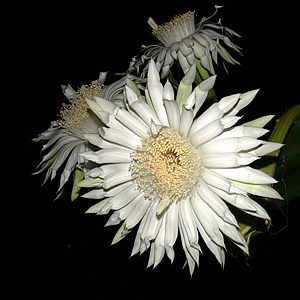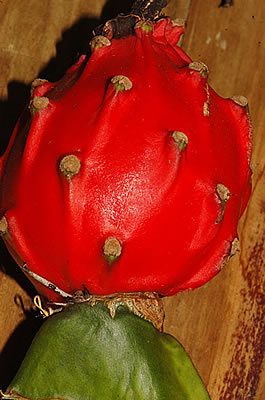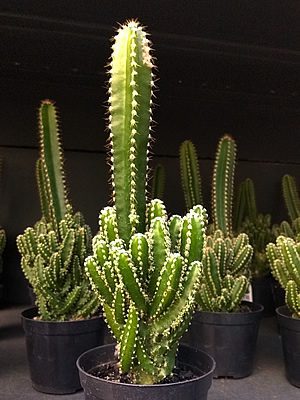The triangle cactus (Acanthocereus tetragonus) is a columnar species, which sometimes behaves as a climber and at other times as a shrub. It is native to coastal regions, as well as sandy and dry scrublands of southern North America, Central America, the Caribbean, and northern South America. In Brazil, a cultivar of the species has become quite popular: The Acanthocereus tetragonus “Fairytale Castle,” a monstrous variation of the species, featuring miniature and compact growth, forming a pyramidal design. Its branches are dark green, and despite the name, can have not only three, but four or five sides. They are leafless, with grayish areolas spaced every 0.8 to 2.4 inches (2 to 6 centimeters).

The spines are radially arranged, numbering 6 to 8 per areola, and each is 0.4 to 1.6 inches (1 to 4 cm) long. The flowers are rare to see in cultivation. It blooms at night, producing beautiful white to greenish flowers, with an orange to red center. Clouds of insects are attracted to the flowers, which makes them even more difficult to observe in nature. After pollination, it forms a red, oblong, edible, and sweet fruit, about 2 inches (5 cm) in diameter, with numerous black seeds, resembling a small Pitaya (Hylocereus sp).

In the garden, the triangle cactus cactus is very versatile, serving various functions. The original plant can be grown as an ornamental climber, decorating patios, balconies, etc. Additionally, it forms impenetrable hedges if cultivated for this purpose, with pruning to encourage branching. Easy to grow, it is extremely hardy, requiring infrequent watering or heavy fertilization.
Not only the fruit, but also the young branches of the plant are edible and can be prepared raw or cooked as vegetables. Thus, they can be consumed in salads, stews, pâtés, with farofa, and many other options, depending on creativity. Nursery growers have a special preference for this species as it is an excellent option for rootstock, considered one of the best.

It should be grown in full sun, in sandy, light soil enriched with organic matter. Resistant to heat and cold down to -7°C (19°F). Water at spaced intervals, ensuring the plant does not become waterlogged. If grown in pots, it can benefit from partial shade, but should receive at least 6 hours of daily sun, a condition found near a north-facing window, for example.
You can use the same light and airy potting mix used for succulents for the triangle cactus. Do not place the plant in a pot on a saucer, as stagnant water will be detrimental, promoting rapid root rot. Fertilize lightly with a teaspoon of slow-release fertilizer, such as Osmocote, or use a fertilizer specifically for cacti. Reduce watering and suspend fertilization in winter.
Propagation is easily done through cuttings, preferably taking branches from the base with the help of a stylus. Allow the branches to dry for 24 hours to heal and then plant them immediately in the appropriate substrate. The plant grown without support in an open environment produces decumbent branches that root when they touch the ground. Thus, you can also take advantage of this natural layering to form new cuttings of the plant.

